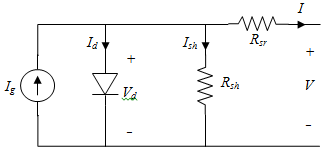

This component can be used to model a photovoltaic (PV) source. The photovoltaic source is assumed to consist of several strings of PV modules connected in parallel, where each string can consist of a number of PV modules connected in series. All PV modules in the array are assumed identical.
The PV cell model used in the components is based on [22]. A solar cell can be represented using the electrical equivalent circuit shown below:

Solar Photovoltaic Cell Model
The photo current, Ig, generated when the cell is exposed to light, varies linearly with solar irradiance. The current Id through the anti-parallel diode is largely responsible for producing the nonlinear I-V characteristics of the PV cell.
Application of the Kirchhoff’s current law to the circuit gives:
|
|
(PV-1) |
Substitution of relevant expressions for the diode current Id and the shunt branch current Ish yields:
|
|
(PV-2) |
In (PV-2), Ig is the photo current and it is a function of the solar radiation on the plane of the solar cell G and the cell temperature Tc:
|
|
(PV-3) |
Where IscR is the short circuit current at the reference solar radiation GR and the reference cell temperature TcR. The parameter αT is the temperature coefficient of photo current (for Silicon solar cells αT = 0.0017 A/K).
The current Io in (PV-2) is called the dark (saturation) current, a function of cell temperature, and given by:
|
|
(PV-4) |
Where IoR is the dark current at the reference temperature. The other parameters appearing in (PV-2) to (PV-4) are the electron charge q, the Boltzmann constant k, the band-gap energy of the solar cell material eg, and the diode ideality factor n which is between 1-2 (1.3 is typical for silicon solar cells).
Since a PV module is composed primarily of series-connected cells, and a PV array is composed of series- and parallel-connected modules, the single cell circuit can be scaled up to represent any series/parallel combination [22, 23].
G: Instantaneous value of solar radiation on the panel (W/m2).
T: Instantaneous value of cell operating temperature (°C).
|
More: |
PSCAD General Reference [22] PSCAD General Reference [23] |